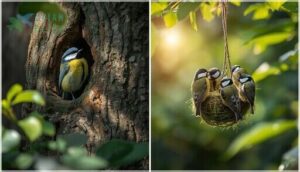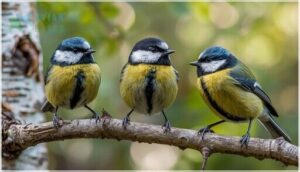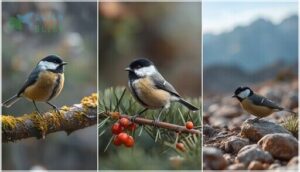This site is supported by our readers. We may earn a commission, at no cost to you, if you purchase through links.

A great tit clings upside-down to a suet feeder, its black cap and white cheeks unmistakable even from across the garden. This acrobatic visitor belongs to the tit family—two closely related groups of small passerine birds (Paridae and Aegithalidae) that have charmed ornithologists and backyard birders alike.
These diminutive birds, weighing barely more than a handful of coins, range from European woodlands to North American forests and even the high grasslands of Tibet. Their success stems from notable adaptations: bills shaped precisely for their preferred prey, plumage that reflects UV light for species recognition, and social structures intricate enough to include cooperative breeding and strategic food hoarding.
Understanding what defines the tit family reveals why these birds thrive in such diverse environments—and how you can welcome them into your own garden.
Table Of Contents
- Key Takeaways
- What is The Tit Family?
- Types of Tit Birds Worldwide
- Physical Characteristics of Tit Birds
- Habitat, Distribution, and Behavior
- Conservation and Attracting Tits to Gardens
- Frequently Asked Questions (FAQs)
- How do tit species adapt to climate change?
- What are the long-term population trends of tits?
- Do tit vocalizations evolve over time?
- How does oxidative stress affect tit breeding success?
- What factors influence tit nest box selection?
- How do tit birds communicate with each other?
- What is the typical lifespan of tit birds?
- How many eggs do tit birds lay?
- Do tit birds migrate during winter months?
- What predators threaten tit bird populations?
- Conclusion
Key Takeaways
- The tit family comprises two distinct groups—Paridae (true tits and chickadees) and Aegithalidae (long-tailed tits)—with roughly 70 species distributed across the Northern Hemisphere, each adapted through specialized bill shapes, UV-reflective plumage, and complex social structures including cooperative breeding and strategic food caching.
- Physical identification relies on distinctive head markings (black caps, white cheeks), varied plumage colors (yellow, blue, grey combinations), and bill morphology that directly reflects diet—insectivorous species display finer bills while seed-eaters have developed stouter ones for cracking harder food sources.
- These birds demonstrate remarkable behavioral flexibility through seasonal dietary shifts (spring insects to autumn seeds), sophisticated foraging techniques with food hoarding for winter survival, and intricate social hierarchies where older males dominate winter flocks while long-tailed tits exhibit kin cooperation with 70% of helpers assisting relatives.
- While most species maintain “Least Concern” conservation status with stable populations, localized threats from habitat fragmentation and climate-driven breeding mismatches require attention—you can support tit populations by installing nest boxes with 32mm entrance holes, providing suet feeders, and cultivating native shrubs that enhance caterpillar biomass essential for chick survival.
What is The Tit Family?
If you’ve ever watched a small, acrobatic bird hanging upside down at your feeder, you’ve likely encountered a member of the tit family. These charming songbirds belong primarily to two families—Paridae and Aegithalidae—and they’re found across Europe, Asia, and North America.
Let’s explore what defines these distinctive birds and why they’ve earned such a special place in backyard birdwatching.
Overview of Tit Birds (Paridae and Aegithalidae)
When you’re exploring bird family classification, you’ll discover tit birds belong primarily to two distinct families: Paridae and Aegithalidae. While the Paridae family encompasses roughly 59 species of true tits and chickadees, Aegithalidae includes 11 species of long-tailed tits and bushtits. Understanding these avian species identification basics helps you recognize:
- Paridae species exhibit colorful plumage and widespread distribution across the Northern Hemisphere
- Aegithalidae members display plainer feather coloration with remarkably long tails
- Both families showcase impressive beak adaptations for insectivorous diets and demonstrate complex avian social bonds
The social behavior of these birds is influenced by their woodland habitat preferences, which play a vital role in their survival and interaction.
Key Physical Traits and Identification
Beyond recognizing the two families, you’ll want to focus on specific bird identification features that help distinguish tit species. Identifying Tit Species becomes straightforward when you understand key physical traits:
| Feature | What to Look For |
|---|---|
| Head Markings | Black caps, white cheeks, contrasting bibs |
| Plumage Colors | Yellow, blue, grey, olive-green combinations |
| Wing Bars | White tipping or edging on flight feathers |
Beak shapes vary by diet—insectivorous species have finer bills, while seed-eaters display stouter ones. Tail lengths differ dramatically, especially in long-tailed tits, where tails comprise half their body length. These feather patterns provide reliable avian species identification markers you’ll recognize at feeders. Understanding the tit bird characteristics is essential for effective identification and appreciation of these species.
Role in Avian Taxonomy
Understanding these physical markers leads naturally to appreciating how taxonomic classification places tits within avian systematics. The Paridae family acts as a model group for studying molecular evolution and species divergence among passerine birds. Phylogenetic analysis using genetic markers has revolutionized our understanding of these species’ relationships:
- Nuclear and mitochondrial DNA studies reveal complex evolutionary patterns within Paridae
- Molecular data separates historically confused groups, clarifying genus-level distinctions
- Genetic research traces the family’s East Asian origins and subsequent dispersal patterns
These taxonomic insights strengthen avian biodiversity conservation efforts while deepening your appreciation for bird behavior and ecology across avian species.
Types of Tit Birds Worldwide
Tit birds have adapted to diverse habitats across continents, resulting in a fascinating array of species with distinct characteristics. From the familiar garden visitors of Europe to the resilient chickadees of North America, each group has evolved unique traits suited to its environment.
Let’s explore the different types of tit birds you might encounter around the world.
Common European Tit Species
Europe hosts six familiar tit species you’ll likely encounter in your garden. The Great Tit, with its distinctive black cap and yellow breast, dominates feeding patterns at winter stations. The Blue Tit’s azure plumage makes identification straightforward.
Long-tailed Tits travel in vocal family groups, while Marsh Tits and Willow Tits—though morphologically similar—occupy different nesting sites and demonstrate subtle variations in breeding habits.
North American Tit and Chickadee Species
North American bird species in the Paridae family include seven Chickadees and several titmice. You’ll recognize the Black-capped Chickadee by its widespread range across Canada and northern states, favoring mixed deciduous woods. The Tufted Titmouse, with its gray crest and rusty flanks, visits bird feeders regularly—one reason its population has expanded northward to approximately 12 million individuals.
Key identification features include:
- Black-capped Chickadees display black caps, white cheek patches, and measure roughly 4.5 inches
- Tufted Titmouse shows distinctive crested head with pale facial markings
- Black-Crested Titmouse inhabits southern ranges with characteristic long black crest
These species exhibit non-migratory feeding patterns, caching seeds in bark crevices for winter survival.
Unique and Lesser-Known Tit Species
Diversity among tit birds extends far beyond backyard regulars. You’ll find endemic species like Taiwan’s Yellow Tit, classified as Near Threatened due to wild bird trade pressures.
India’s White-naped Tit displays striking black-and-white patterns, while the Green-backed Tit inhabits mountainous forests across South and Southeast Asia.
These rare tits face conservation challenges, with Willow Tit populations declining 86% in the UK between 1995 and 2020.
Differences Between Paridae and Aegithalidae
Despite sharing the common name “tit,” you’ll notice these birds belong to two distinct families with fascinating phylogenetic relationships. The Paridae family includes true tits, while Aegithalidae encompasses long-tailed tits—only distantly related within avian taxonomy.
Key differences in morphological adaptations include:
- Physical characteristics: Paridae members show stocky builds with short, strong bills; Aegithalidae species feature longer tails and tiny bills
- Nesting strategies: True tits use tree cavities; long-tailed tits construct elaborate hanging pouches
- Social behavior: Aegithalidae display cooperative breeding with flock helpers
- Habitat preferences: Paridae favor diverse woodlands; Aegithalidae prefer forest edges
Physical Characteristics of Tit Birds
Despite their small size, tit birds pack considerable physical diversity into compact frames. From bill shape to plumage patterns, these features reveal how different species have adapted to their environments and food sources.
Let’s examine the key physical traits that help you identify and understand these charming garden visitors.
Size, Weight, and Bill Variations
If you’re wondering how tit birds stack up, you’ll find surprising variety. Their body length generally spans 10 to 16 cm, while weight ranges from 7 to 29 grams. Bill shape evolution reflects dietary adaptations—insectivorous species sport finer bills, whereas seed-eaters display stouter ones. Morphometric species comparisons reveal these birds maintain a conservative body structure despite size sexual dimorphism and weight seasonal changes affecting individual populations.
| Physical Trait | Range/Variation |
|---|---|
| Body Length | 10–16 cm (most species) |
| Weight | 7–29 grams |
| Bill Shape | Fine (insect-eaters) to stout (seed-crackers) |
Plumage Colors and Patterns
You’ll encounter fascinating plumage patterns across tit species, driven by sexual dichromatism and regional variation. Carotenoid pigments create vibrant yellows and blues, while feather microstructure enhances UV reflectance. Bird plumage and markings reveal five major color morphs—black, blue, white, red, and mixed—with males generally displaying brighter coloration than females.
- Head and chest regions show greater complexity than wings
- Blue Tits exhibit condition-dependent yellow breast signals
- Intermediate climates produce the most elaborate types of bird plumage
Adaptations for Diet and Habitat
Your local tits aren’t picky eaters—they’re dietary shape-shifters. Bill morphology reflects this flexibility: insect-eaters sport finer bills, while seed-lovers develop stouter ones. Great tits on mealworm diets show 23% shifts in their dietary microbiome, while blue tits ramp up digestive enzymes by 35% when seeds dominate winter feeding. This physiological plasticity lets them master seasonal adaptations across diverse habitat shifts.
| Adaptation Type | Example |
|---|---|
| Bill Structure | 8–14 mm range permits insects to seeds |
| Enzyme Activity | 35% amylase increase on seed diets |
| Microbiome Shift | 23% composition change with protein |
| Foraging Behavior | 49% of seeds cached in winter |
| Diet Composition | Urban: 58–73% plant vs. rural insects |
Habitat, Distribution, and Behavior
Tit birds have carved out niches across diverse landscapes, from dense European woodlands to North American oak savannahs and even the remote Tibetan Plateau. Their adaptability shows in how they’ve settled into everything from ancient pine forests to suburban gardens, each species fine-tuned to its particular environment.
Understanding where these birds live and how they behave gives you insight into their striking survival strategies and social dynamics.
Preferred Habitats and Geographic Range
You’ll find tit birds across most of Europe, Asia, North America, and parts of Africa—their global distribution spans from Scandinavia to Alaska and south to Mexico.
Habitat preferences vary by subspecies: great tits thrive in deciduous woodlands and urban parks, while ground tits inhabit Tibetan grasslands above 3,350 meters. Urban densities reach 50 pairs per km² in southern Finland, demonstrating striking altitudinal adaptations and species distribution patterns across diverse geographic zones.
Social Structure and Territoriality
Beyond their geographic range, tit birds reveal fascinating social structures rooted in flock hierarchies and kin cooperation. Older males dominate winter flocks, controlling resource competition.
During breeding, territoriality intensifies—males engage in vocal duels defending their breeding territories. Long-tailed tits exemplify striking kin cooperation: approximately 70% of helpers assist relatives, using learned calls to identify family. Dispersal patterns show males remain near natal sites, strengthening these cooperative bonds.
Male tit birds fiercely defend breeding territories through vocal duels, while long-tailed tits demonstrate remarkable kin cooperation with 70% of helpers assisting relatives
Foraging Techniques and Diet
Tit birds demonstrate intricate foraging techniques shaped by prey selection and social learning. You’ll notice three primary dietary patterns:
- Insects dominate spring diets—blue tits deliver 59% green larvae to nestlings, while great tits prefer larger prey items.
- Seasonal shifts occur—autumn brings high-energy seeds and nuts for fat reserves.
- Food hoarding supports winter survival, with chickadees caching resources strategically.
Orchard predation rates peak 100 meters from margins, revealing adaptive foraging behavior.
Conservation and Attracting Tits to Gardens
While most tit species remain relatively stable, habitat loss and fragmentation pose real threats to their populations. Protecting woodland habitats isn’t just good for conservation—it directly affects whether these birds will visit your backyard.
Here’s what you need to know about their conservation status and how you can create a welcoming space for them in your own garden.
Conservation Status and Threats
Most tit species hold “Least Concern” status on the IUCN Red List, with Great Tits numbering 440–695 million globally. However, localized declines are driven by habitat fragmentation, disease outbreaks like Suttonella ornithocola, and pollution impacts near industrial zones.
Climate adaptation challenges—especially breeding mismatches with caterpillar peaks—threaten specialized populations. Conservation of bird species requires monitoring these ecosystems closely, as habitat loss remains the primary threat to bird conservation efforts worldwide.
Importance of Habitat Preservation
Survival depends on connected woodland habitats—fragmentation disrupts ecosystem roles and creates nesting site shortages that leave tits vulnerable. Forest ecosystems need decades to mature, so losses now echo through generations.
Urbanization impacts and climate mismatches compound these pressures, reducing food availability when chicks need it most.
Protecting and restoring forest fragmentation zones sustains not just tits, but entire ecosystems they help maintain.
Tips for Attracting Tits to Your Garden
How can you transform your garden into a haven for tits? Strategic habitat features draw these birds reliably.
Here are five key practices:
- Nest box installation with 32 mm entrance holes at 2.5 meters height achieves over 50% occupancy in UK gardens.
- Food source provision through suet balls and mixed seed feeders placed 1.5 meters up increases visitation rates substantially.
- Insect population enhancement via native shrubs like hawthorn bolsters caterpillar biomass—essential for chick survival.
- Safe water provision in shallow baths with daily cleaning reduces disease transmission.
- Garden structure design combining dense cover and open sightlines raises tit diversity by 21%.
These practices align bird diet and feeding habits with natural foraging behaviors, creating sustainable backyard ecosystems that benefit multiple species visiting bird feeders throughout the year.
Frequently Asked Questions (FAQs)
How do tit species adapt to climate change?
Climate change pushes birds like great tits and blue tits to breed earlier each spring. Genetic adaptation and phenological shifts help, but asynchrony with food peaks threatens population dynamics, creating extinction scenarios despite conservation efforts across their geographic distribution.
What are the long-term population trends of tits?
You’d think all garden birds are thriving, but Long-tailed Tit populations doubled in the UK from 1969 to 2014, while Willow and Marsh Tits face sharp declines from habitat degradation—warranting urgent conservation status updates.
Do tit vocalizations evolve over time?
Yes, tit vocalizations evolve remarkably. Cultural transmission shapes song frequency and syntax structure across generations, while urban adaptation drives earlier dawn choruses. Population dynamics and immigration accelerate vocal changes in these intelligent songbirds.
How does oxidative stress affect tit breeding success?
Like Icarus flying too close to the sun, tit birds face oxidative stress during reproduction. Higher resistance boosts fledgling survival, but increased parental effort—especially in larger broods—reduces antioxidant defenses, creating critical life-history tradeoffs affecting breeding success.
What factors influence tit nest box selection?
Box height, neighbor proximity, material type, and vegetation cover greatly influence your nest boxes’ appeal to tit birds. Wooden boxes outperform plastic for fledging success, while elevated, well-spaced placements improve nesting outcomes and reuse dynamics in gardens.
How do tit birds communicate with each other?
Tit birds communicate through complex vocalizations, including alarm calls that encode predator threat levels, distinct song variations for territory defense, and visual signals like wing-fluttering displays.
Their communication system combines call syntax with gestures for coordinated flock responses.
What is the typical lifespan of tit birds?
Most species in the Paridae family live 2-3 years in the wild, though maximum ages exceed 9-10 years. Juvenile mortality, predation effects, and environmental factors critically influence longevity.
Breeding impact and population lifecycles vary across species.
How many eggs do tit birds lay?
You’ll usually find most tit species laying between 6 and 12 eggs per clutch during breeding season, though blue tits can produce up to
Environmental factors like habitat quality affect final clutch size greatly.
Do tit birds migrate during winter months?
You’ll find that nearly every tit bird you spot in winter is probably a year-round resident, though northern populations do exhibit short-distance migration behaviors when climate impacts trigger winter survival strategies.
What predators threaten tit bird populations?
You’ll notice sparrowhawks pose the greatest avian threat, while squirrels and snakes act as nest robbers.
Urban environments reduce mammal threats somewhat, but predator avoidance and nest defense behaviors remain critical for survival.
Conclusion
Good things come in small packages“—and few birds prove this better than the tit family. From their UV-reflective plumage to intricate social behaviors, these adaptable passerines thrive across continents by mastering their ecological niches.
Whether you’re identifying a great tit’s bold markings or coaxing chickadees to your feeder with sunflower seeds, you’re witnessing evolutionary success in miniature. Welcome them into your garden, and you’ll gain lively, acrobatic companions who reward close observation year-round.










